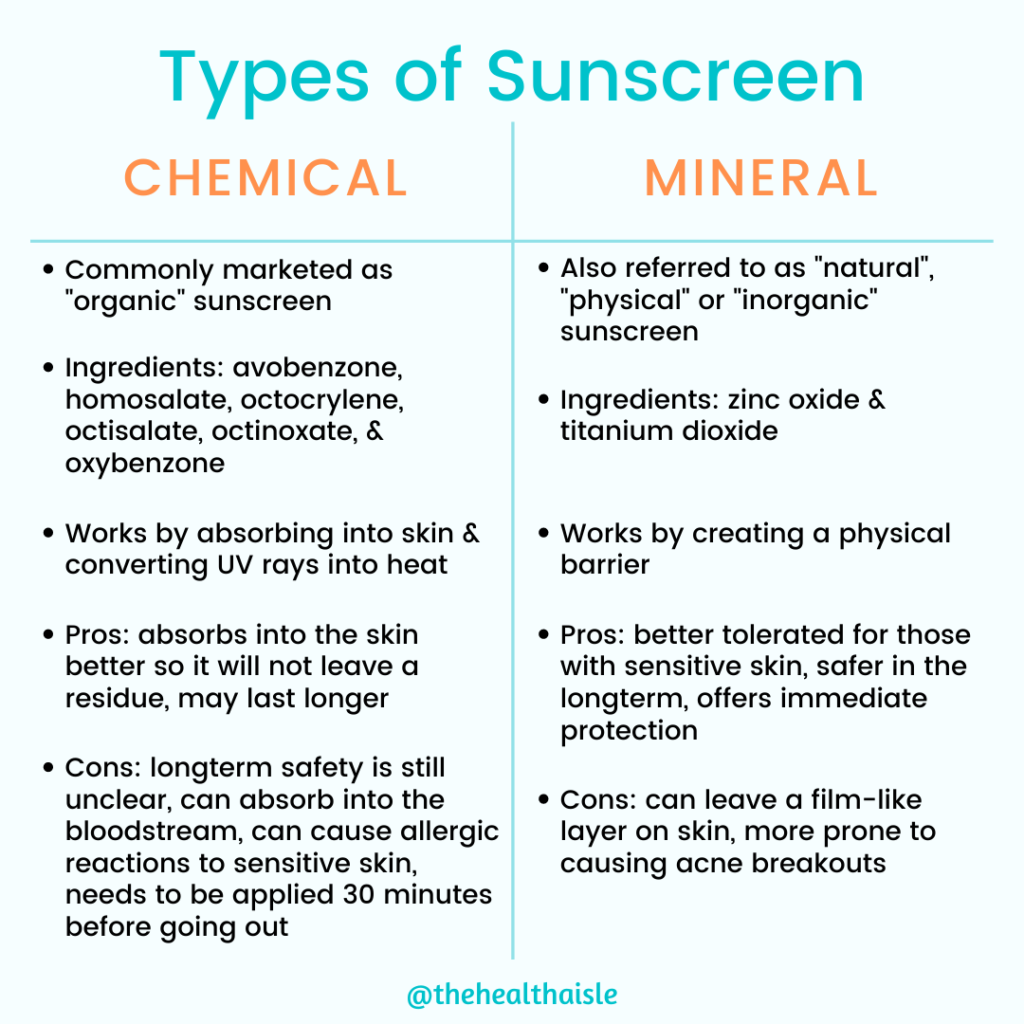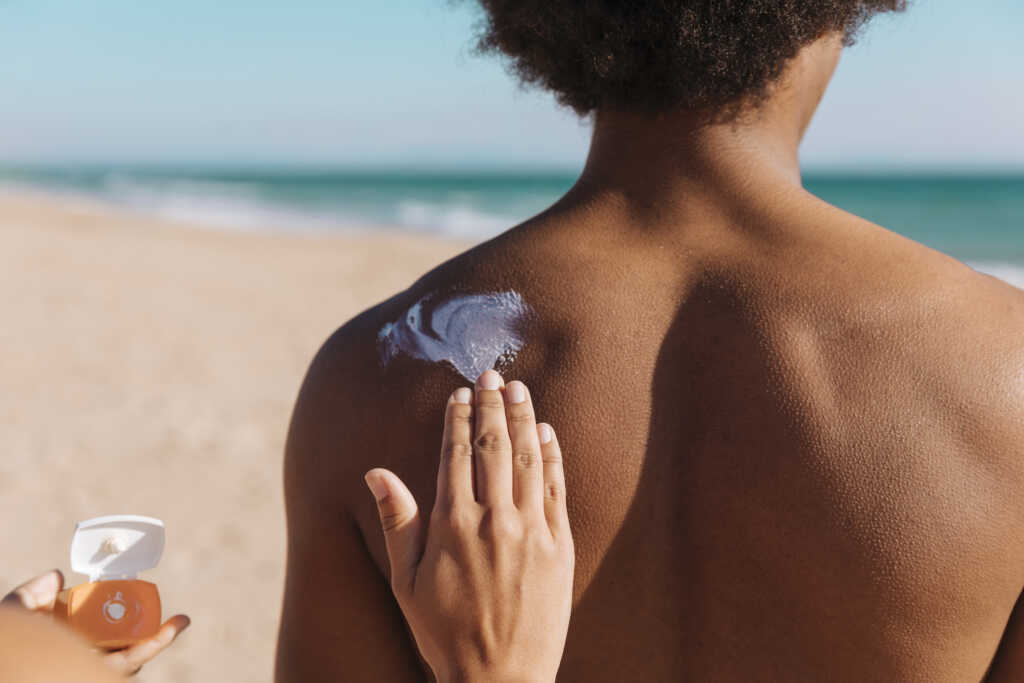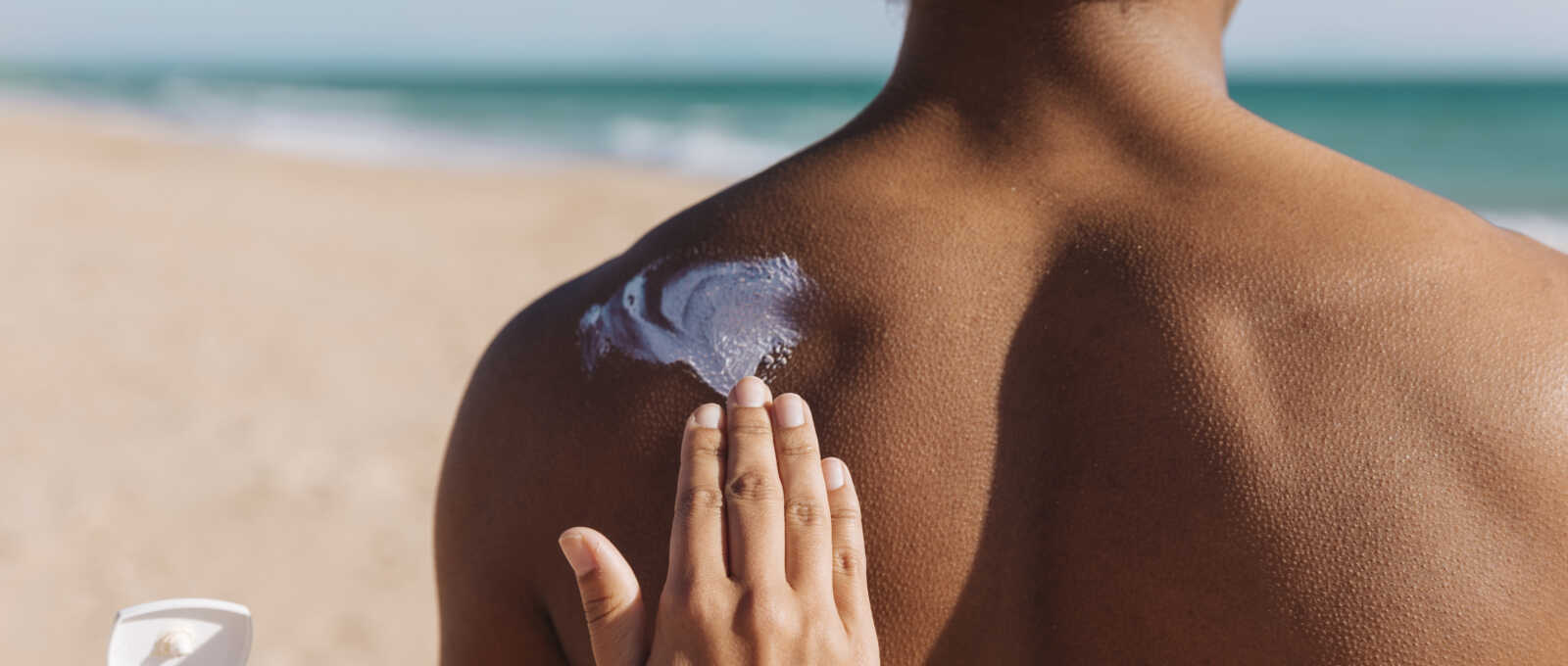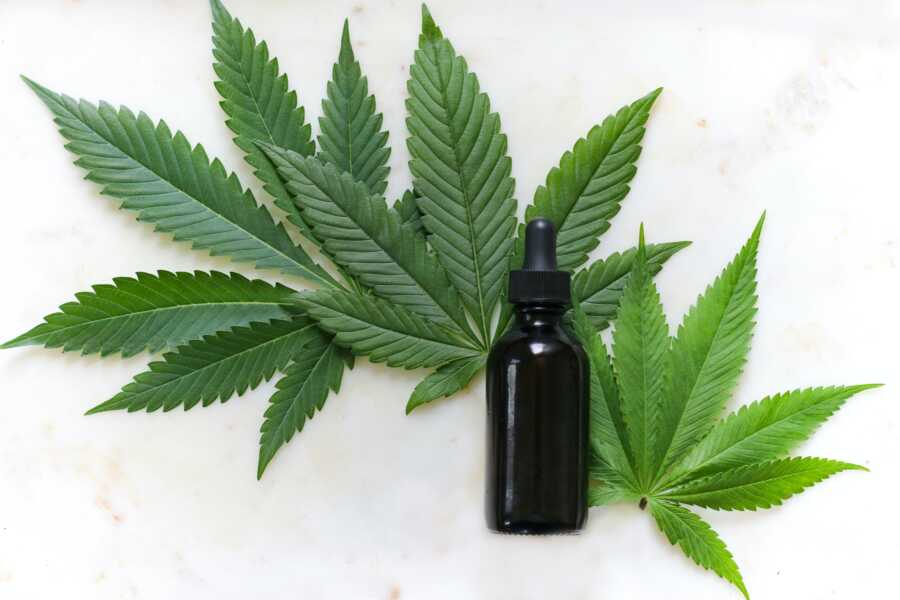It is often overwhelming choosing a sunscreen product because there are so many to chose from. These products range from being the conventional sunscreens (often marketed as organic) to newer mineral sunscreen brands. As we are become health conscious and environmental shoppers we often look for labels such as “organic” and”natural”. If you have questions or wondering if you should be using mineral sunscreen, you’ve come to the right place.
- What is the difference between mineral and chemical sunscreen?
- Why Do Mineral Sunscreens Leave a White Film?
- Is There a Difference Between Titanium Dioxide and Zinc Oxide?
- Are Mineral Sunscreens Safe?
- Bottom Line
What is the Difference Between Mineral and Chemical Sunscreen?
- the two approved ingredients are zinc oxide and titanium dioxide which are small particles that sit on the skin’s surface
- physically prevent UV rays from penetrating the skin. Because they sit on top of the skin and create a physical barrier
- Often create a “white” film-like layer
- Better tolerated for people that have sensitive skin but may be a trigger for those who have acne because of how they sit on top of the skin
- May also require more frequent applications because they rub off more easily.
Chemical sunscreens:
- most common ingredients are oxybenzone, avobenzone, octisalate, octocrylene, homosalate, and octinoxate which allow UV light into the skin
- once the light is absorbed into the skin, a chemical reaction occurs where UV light is converted to heat, which then dissipates
- they absorb better so don’t usually leave a film on the skin
- more likely to cause skin irritation if you have sensitive skin – such as allergies, rosacea or melasma (which are brown spots).

Why Do Mineral Sunscreens Leave A White Film?
Mineral sunscreen formulations sit on top of the skin which end-up leaving a thick and white residue on the skin[2]. To make them more transparent and cosmetically appealing, manufacturers have reduced the particle size of titanium dioxide and zinc oxide to micro-sized particles.
When the particle size was further reduced to a nanoparticle, UVA protection decreased in both titanium dioxide and zinc oxide[1]. Additional research was done to find a balance between a smaller particle size and complete UVB/UVA protection. The optimum formulation was found to contain nano-sized titanium dioxide as well as a mixture of both micro- and nano-sized zinc oxide particles.

Is There a Difference Between Titanium Dioxide and Zinc Oxide?
Studies have shown that micro-sized titanium dioxide is effective at blocking UVB rays and micro-sized zinc oxide is useful against UVA rays. Using a combination of these two minerals would therefore provide the best broad-spectrum protection[1].
Are Mineral Sunscreens Safe?
At this time, both the ingredients found in mineral sunscreens (titanium dioxide and zinc oxide) are considered safe ingredients.
There are three main concerns with regards to mineral sunscreen products containing titanium dioxide and zinc oxide nanoparticles:
#1 – Do the Nanoparticles Get Absorbed Into The Skin?
Research into sunscreen formulations has shown that both titanium dioxide and zinc oxide form clusters or aggregates in the preparations[3]. This makes penetration of individual nanoparticles into the skin is less likely due to the nature of the size of these particles. In addition, multiple studies have concluded that there is no measurable penetration of metal oxide nanoparticles through intact skin[4].
#2 – Do titanium dioxide and zinc oxide nanoparticles generate toxic molecules when exposed to UV radiation?
Conflicting research has shown that in the presence of sunlight, titanium dioxide and zinc oxide nanoparticles can produce reactive oxygen species (ROS) which have the ability to damage cells[5]. To counteract this, manufacturers coated the nanoparticles, and that has been shown to reduce the formation of ROS. As well, the skin contains natural antioxidants which are able to neutralize ROS[5].
Based on the available evidence, it has been shown that sunscreen products containing titanium dioxide and zinc oxide nanoparticles are safe to use on intact human skin. The consistent shedding of skin cells and growth of hair follics prevents accumulation of nanoparticles within the skin[5]. Further research is needed to determine the toxicity of these nanoparticles on damaged skin.
#3 – What About Spray Sunscreens?
There is some potential risk when titanium dioxide or zinc oxide are inhaled by humans. The Environmental Working Group has recommended against powdered products or spray sunscreens because of risk of these nanoparticles may have to the lungs[2].
Bottom Line
Mineral sunscreen formulations using micro- or nanoparticles are for the most part, a safe and effective product. They have less risk of skin irritation compared to chemical sunscreens but should not be used on children under 6 months of age or applied to damaged skin.
Sunscreens should be used for all skin types. Look for mineral sunscreens with an SPF of at least 30 that contain both titanium dioxide and zinc oxide for broad-spectrum protection. Formulations using micro- or nanoparticles result in a safe, effective, and more cosmetically appealing product.

Note: Proper sunscreen application is just as important as product selection. Be sure to check the expiration date and follow the directions on the label. Sunscreen should be used in combination with shade and protective clothing.
Authors: Lei Li, Long Quach, Sarah Crouch, BSc. Pharm Candidate(s)
University of Alberta
Edited and Reviewed by The Health Aisle
References:
1. Smijs, T. G., & Pavel, S. (2011). Titanium dioxide and zinc oxide nanoparticles in sunscreens: focus on their safety and effectiveness. Nanotechnology, science and applications, 4, 95–112. https://doi.org/10.2147/NSA.S19419
2. Schneider, SL, Lim, HW. A review of inorganic UV filters zinc oxide and titanium dioxide. Photodermatol Photoimmunol Photomed. 2019; 35: 442– 446. https://doi.org/10.1111/phpp.12439
3. Schilling, K., Bradford, B., Castelli, D., Dufour, E., Nash, J. F., Pape, W., Schulte, S., Tooley, I., van den Bosch, J., & Schellauf, F. (2010). Human safety review of “nano” titanium dioxide and zinc oxide. Photochemical & photobiological sciences : Official journal of the European Photochemistry Association and the European Society for Photobiology, 9(4), 495–509. https://doi.org/10.1039/b9pp00180h
4. Sadrieh, N., Wokovich, A. M., Gopee, N. V., Zheng, J., Haines, D., Parmiter, D., Siitonen, P. H., Cozart, C. R., Patri, A. K., McNeil, S. E., Howard, P. C., Doub, W. H., & Buhse, L. F. (2010). Lack of significant dermal penetration of titanium dioxide from sunscreen formulations containing nano- and submicron-size TiO2 particles. Toxicological sciences : an official journal of the Society of Toxicology, 115(1), 156–166. https://doi.org/10.1093/toxsci/kfq041
Photo Credits:
Hand photo created by freepik – www.freepik.com




Leave a Comment